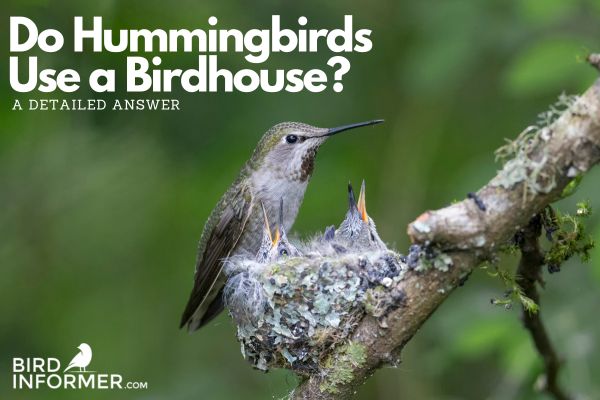Contents
Imagine your backyard transformed into a magical oasis, filled with the delightful presence of tiny, colorful hummingbirds. Creating a hummingbird-friendly yard not only brings the beauty and wonder of these fascinating birds closer to home, but also helps protect their fragile habitats.
Hummingbirds do not use birdhouses. Contrary to common belief, hummingbirds are inherently unfit for residing in birdhouses, irrespective of their dimension, design, or hue. While certain varieties of garden birds may adapt to living in a birdhouse, hummingbirds do not fall into this category. Thus, in your search for a “birdhouse for hummingbirds,” be cautious of misleading advertising!
However, keep reading this article to learn how to create a hummingbird-friendly environment where they will nest and feed in your backyard.
In this blog post, we’ll explore how to make your yard irresistible to nesting hummingbirds, discuss their unique behaviors, and provide tips for observing and protecting their nests, including the question: do hummingbirds use a birdhouse?
Short Summary
- Learn about hummingbirds’ nesting preferences, flight patterns & mating habits to create a bird-friendly environment.
- Plant native flora with nectar-rich flowers, provide water sources and use natural alternatives for pesticides.
- Observe nests from afar using optics and install predator guards to protect them!
Understanding Hummingbird Behavior
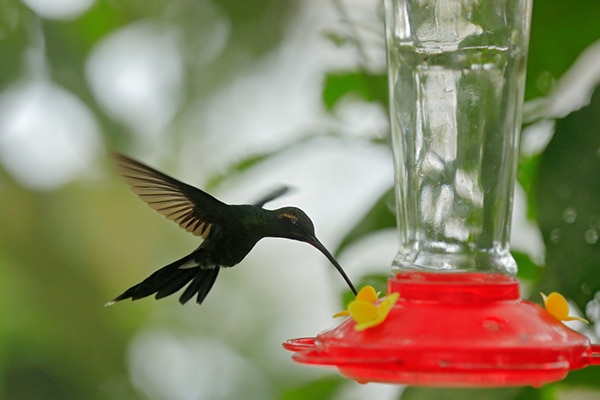
Hummingbirds are truly remarkable creatures. Their incredible ability to hover, dart, and even fly backward makes them stand out among other birds. As enchanting as they are, creating the perfect environment to attract them to your yard requires understanding their nesting preferences, flight patterns, and mating habits.
This knowledge will help you provide the ideal conditions for these tiny birds to thrive.
Nesting Preferences
Hummingbirds are very particular when selecting a nesting site. It is important for them to find one that is safe and provides the correct environment. They typically choose high, sheltered locations in deciduous trees or dense shrubs, close to water and nectar-rich flowers. These tiny bowl-shaped nests are meticulously crafted using spider silk, plant down, leaves, and other bits of plants.
Female hummingbirds are resourceful and have even been known to build their nests in unusual places, such as porch lights, backyard fountains, and hanging flower baskets. It’s important to create a yard that offers suitable nesting sites for hummingbirds to feel at home. Providing a variety of trees and shrubs with a range of heights, as well as a safe and sheltered environment, will encourage these charming birds to nest nearby.
Flight Patterns
Observing a hummingbird in flight is an awe-inspiring experience. Their unique flight patterns consist of sweeping their wings horizontally in a U or oval shape, enabling them to hover and maneuver with precision.
In courtship dives, they can reach speeds of up to 60 miles per hour. Understanding their flight patterns can help you design a yard that provides ample space for hummingbirds to exhibit their aerial acrobatics.
Mating and Breeding Habits
During breeding season, hummingbirds become quite territorial, protecting their nests and young from potential threats. Females build the nest on their own, using bits of bark, leaves, and fluffy material like plant down, shaping it into a cup and lining it with soft materials such as feathers or moss.
It is vital to provide a safe nesting environment, as well as ample food sources, in order to support these tiny birds during their breeding season.
Creating a Hummingbird-Friendly Environment
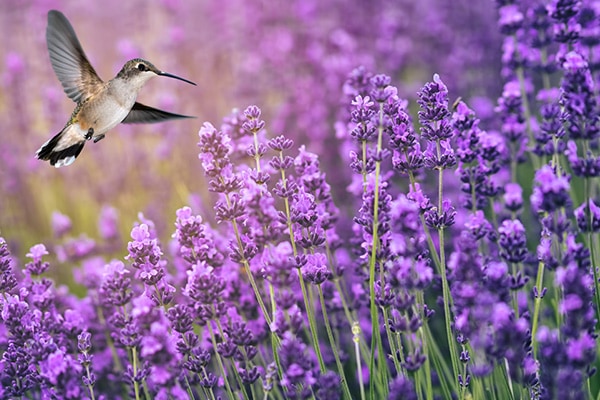
To create a haven for hummingbirds, focus on three main aspects: planting native flora, providing water sources, and ensuring safety and security. By addressing these elements, you’ll not only help support local hummingbird populations, but also create a beautiful and lively yard that you can enjoy all season long.
Native plants are essential for hummingbirds, as they provide food and shelter. Look for plants that produce nectar-rich flowers, such as columbine, bee balm, and cardinal flowers. Additionally, provide a variety of services.
Planting Native Flora
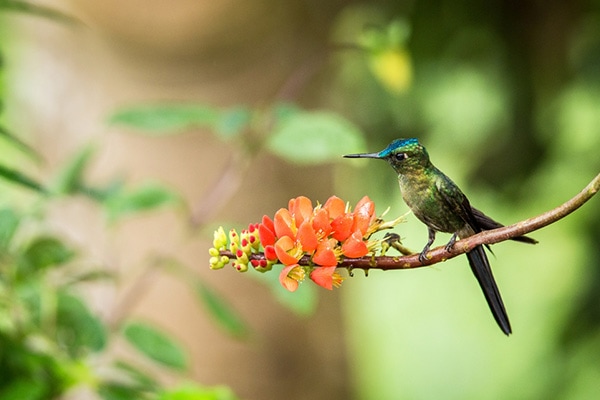
Planting native flora is crucial for attracting hummingbirds, as it provides them with a reliable food source and a familiar environment. Some excellent choices for hummingbird-friendly plants include trumpet creeper, beebalm, trumpet honeysuckle, cardinal flower, columbine, coral honeysuckle, and blue lobelia.
By incorporating these nectar-rich flowers into your yard, you’ll not only create an inviting habitat, but also contribute to the preservation of native plant species.
Providing Water Sources
Hummingbirds need access to clean water for drinking and bathing to stay healthy and hydrated. They prefer shallow water sources such as misters, drippers, water fountains, or solar fountains.
Setting up a birdbath or other water features in your yard will not only attract hummingbirds, but also enhance the overall ambiance of your outdoor space.
Ensuring Safety and Security
A vital aspect of creating a hummingbird-friendly environment is ensuring their safety and security. This includes regular cleaning and maintenance of feeders, keeping insects at bay, and discouraging unwanted visitors. Offering shelter in the form of birdhouses or sheltered areas in trees can protect hummingbirds from storms and provide a safe place to rest.
To minimize potential hazards, avoid using chemical pesticides in your yard. These chemicals can be deadly to birds and eliminate essential food sources like insects. Opt for natural alternatives, such as insect-repelling plants or insecticidal soaps, to keep your yard hummingbird-friendly and eco-conscious.
Alternative Nesting Options for Hummingbirds
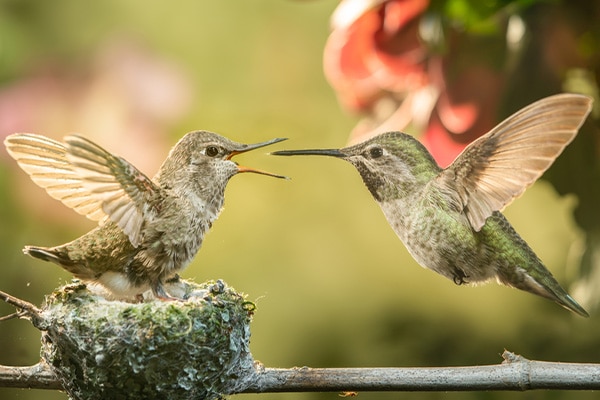
While traditional birdhouses may not be the preferred choice for hummingbirds, there are alternative nesting options that can be just as effective. Nesting platforms, natural grass huts, and DIY hummingbird houses can provide these fascinating birds with suitable nesting sites, ultimately enhancing their chances of survival and reproduction.
Nesting Platforms
Nesting platforms are designed to encourage hummingbirds to build their nests in a specific area. However, it’s important to note that artificial nesting platforms may not offer the same safety and security as natural nesting sites, such as tree branches or dense shrubbery.
Nevertheless, they can be a viable alternative, especially in areas where natural nesting sites are scarce.
Best Hummingbird Nest Perch
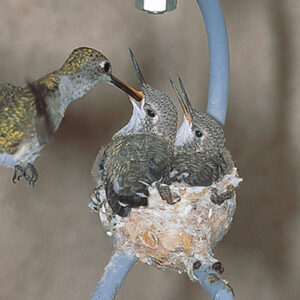
Duncraft Hummingbird House, Set of 2
Duncraft’s Hummingbird House mimics the “forked” tree branches of a hummingbird’s preferred nesting location. Features a leaf “umbrella” for overhead protection with a landing branch and starter nesting material.
This Hummingbird House has proven successful with the following species: Anna’s Hummingbirds, Black-chinned, Broad-tailed, Magnificent and common Ruby-throated Hummingbirds.
Mount under your eaves or in a corner. This comes with two metal nesting frames because hummingbirds often start two nests, only to choose the least windy location.
- 2-1/2 x 3 inches tall.
- Attract hummingbirds to build their nest nearby
- Features “forked” branches, where hummingbirds prefer to nest
- Includes mounting hardware with complete instructions
Natural Grass Huts
Natural grass huts are structures made from sustainably sourced, 100% handwoven natural grass, which serve as nesting sites for hummingbirds. These eco-friendly options blend seamlessly into the natural environment and provide shelter and security for nesting birds.
A popular option is the Kimdio Hand Woven Hummingbird Hut, which is both practical and stylish, making it an excellent choice for your yard.
Observing and Protecting Hummingbird Nests
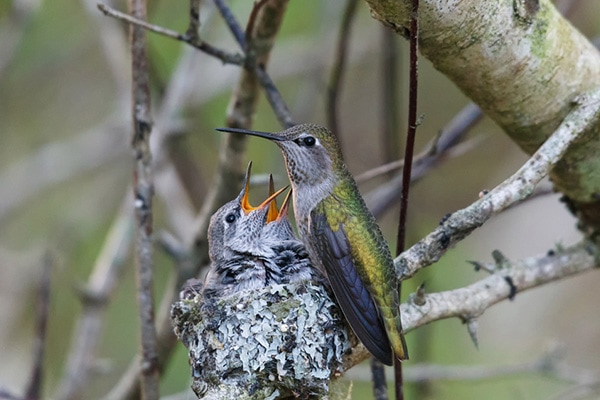
Watching hummingbirds build their nests, raise their young, and thrive in your yard is a rewarding experience. However, it’s important to approach this with care and consideration to ensure their safety and well-being.
In this section, we’ll discuss how to locate hummingbird nests, proper observation etiquette, and ways to protect them from predators.
Locating Nests
Finding hummingbird nests can be a challenge, as they are usually well-hidden in trees, shrubs, or other vegetation. To locate a nest, observe the hummingbirds’ behavior, and look for their preferred nectar sources.
If you spot a female hummingbird, watch her from a distance and follow her back to her nest, ensuring you do not disrupt her or her chicks.
Observation Etiquette
When observing hummingbird nests, it’s crucial to maintain a respectful distance of at least 10 feet away. Disturbing the nest could cause the birds to abandon it, leaving the eggs or young birds exposed to predators.
To get a closer look, use binoculars or a camera with a zoom lens, allowing you to enjoy these fascinating birds without causing them any stress or harm.
Protecting Nests from Predators
Protecting hummingbird nests from predators, such as cats, dogs, and snakes, is essential for their survival. Installing predator guards on birdhouses and trees with nests can help deter potential threats.
Additionally, minimize pesticide use, as it can wipe out essential food sources and prove lethal to birds. By taking these precautions, you can ensure the safety and well-being of nesting hummingbirds in your yard.
Summary
Creating a hummingbird-friendly environment can be a rewarding and gratifying experience. By understanding their unique behaviors, providing suitable nesting sites and resources, and ensuring their safety, you can transform your yard into a haven for these fascinating birds. As you watch hummingbirds thrive and flourish in your very own backyard, you’ll no doubt feel a sense of pride and accomplishment in contributing to the conservation of these captivating creatures.
Frequently Asked Questions
Can hummingbirds live in a birdhouse?
Hummingbirds are unfortunately unsuited to living in birdhouses, regardless of the size, shape or color of the box. With some other types of backyard birds, it may be possible for them to take up residence in a birdhouse, but hummingbirds are not one of them.
So, if you’re looking for a “hummingbird birdhouse,” don’t be fooled by the marketing!
What kind of birdhouse does a hummingbird live in?
Hummingbirds don’t live in a typical birdhouse like other birds. Instead, they prefer to build their own nests in the crook of a forked tree branch, around a foot away from the trunk.
So if you want to attract hummingbirds, it’s best to look for more natural solutions instead of buying or building a traditional birdhouse!
Where should a hummingbird birdhouse be placed?
When placing a hummingbird birdhouse, it’s important to choose a sheltered location that will protect it from wind and rain. Placing the house near trees or shrubs that provide cover is ideal, as it gives the birds easy access to the house.
Consider positioning your house on a high branch, under the edge of your roof or near other plants that will attract hummingbirds.
What do hummingbirds like to nest in?
Hummingbirds like to nest in the forked branch of trees, within the branches of plants, or deep in dense bushes. They also use moss and lichen to camouflage their nests, as well as spider silk for added protection.
To encourage nesting, plant deciduous trees and large shrubs that provide shelter from predators at varying heights.

